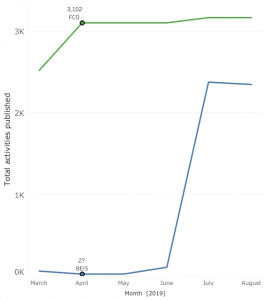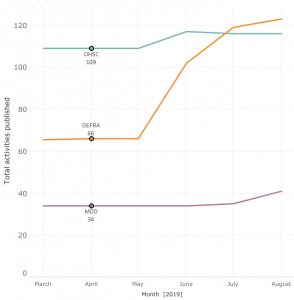The New Oceans of UK Aid Information: What Does the Data Reveal?
Pressure has been mounting on UK government departments to improve their aid transparency after the Independent Commission for Aid Impact’s State of UK Aid report found low levels of transparency in government departments on their Official Development Assistance (ODA) spending. Independent bodies such as the National Audit Office have reported on the need for greater clarity on aid spending in order to assess aid effectiveness. This follows the UK government’s internal target, approved in the 2015 aid strategy, for departments which spend ODA to achieve at least ‘Good’ in the Publish What You Fund Aid Transparency Index.
For those of you following our work more closely you will know that throughout 2019 we have been conducting a transparency review of 10 UK government departments and two cross-government funds (The Prosperity Fund and The Conflict, Stability & Security Fund). The review includes a close look at 35 indicators: from project attributes, performance, finance and organisational policies in order to check for quality and quantity across the portfolio of ODA spending. With this review we got to look more closely at the newer aid spending departments where, since 2016, the ODA budget has been increasing.
Since early 2019, as these departments have come to understand the details of our methodology, learn about the International Aid Transparency Initiative (IATI) standard and invest in the systems and processes to enable greater transparency, there has been a steady increase in government departments publishing more data. The review deadline has been a good advocacy tool to increase both the number of departments providing data, and the comprehensiveness of this data.


We have charted the publication rate of five departments during 2019 to get a sense of how much aid data publication has increased. In early April, when our review was launched, we saw a sharp increase in data publication from the Foreign and Commonwealth Office to over 3,000 data sets. Following some initial engagement, other department such as the departments for Health and Environment increased publication in May; the Department for Environment, Food and Rural Affairs went from just over 60 publications to over 120. This was followed by the Department for Business, Energy and Industrial Strategy’s publications jumping to 2,000 in June as they came closer to our review deadline.
Consequently, there is now a lot more information freely available on UK aid spending which until as recently as August was simply not available. This data can be accessed through the government’s own website and is also searchable through IATI’s d-portal and query builder tools. The results of our review will be announced in January 2020, but in the meantime we wanted to reflect on the newly available data that the departments are now sharing, many for the first time.
More data more questions
With the publication of this data we are now starting to get a clearer picture of the aid priorities of these 10 government departments; we can compare and contrast these with each other and the UK aid strategy for alignment and divergence. Most of the departments now have an organisational file where a high-level overview of their aid strategy, sector specific focuses and policies are kept. Publish What You Fund has built a handy tool – ‘decipher’ – that can assist with viewing IATI data in the org file easily. Check it out here.
Often these policies and strategies cross-over with their non-ODA policies and procedures and, where they do, we can see if they adequately set out the approach to ODA spending or if the department has had to take on greater responsibility with ODA spending, and the greater scrutiny that comes with it, by writing ODA specific policies. In some cases, departments which traditionally have had very little transparency have had to open up more and we can see better what some of their work abroad actually entails.
There is now more information available on project attributes such as dates, descriptions, implementing countries and partners which could be further used to investigate UK ODA effectiveness:
- Is UK ODA now targeting the lowest income countries or, does spend on the lowest income countries vary by department?
- Is UK aid targeting rural or urban areas and in which sectors: construction or social services?
- How are cross cutting priority issues such as gender, disability and environment being addressed across the board?
- Who are departments partnering with to implement their ODA strategies? Are these primarily organisations in developing countries or secondary implementers from within the UK?
Not only this but we can now access specific objectives at the national and project level against which we can measure success rates using results and evaluations documentation (where available) such as logframes and reports. From this we can understand better what objectives are most important to each department and whether they have been able to use their department specific skill-set to focus on areas where they can have the most impact. What kinds of aid objectives will the Department for Digital, Culture, Media and Sport administer ODA against in comparison to the Department for Education? How will each department assess their aid impact? Will it be through quantitative or more qualitative assessments? In addition, we can see if the availability of performance data has aided cross government learning.
With financial data we can see how much is being spent and where, both with commitments, budgets and actual spend. Users can now follow the money to see how departments prioritise spending and in some cases how much the administration costs of a department’s ODA are. To what extent is spending done in cross-government collaboration, leveraging expertise from multiple departments or are departments’ predominantly implementing programmes by themselves?
Users need to be wary however that reporting can still vary as the departments become familiar with publishing to the IATI standard and as they improve their internal data management systems. Publish What You Fund welcomes the push for greater transparency. Particularly we welcome further efforts to capture aid performance and effectiveness data to be shared amongst government departments. Keep an eye out for the full UK Aid Transparency Review report, coming out early next year, to find out more.

